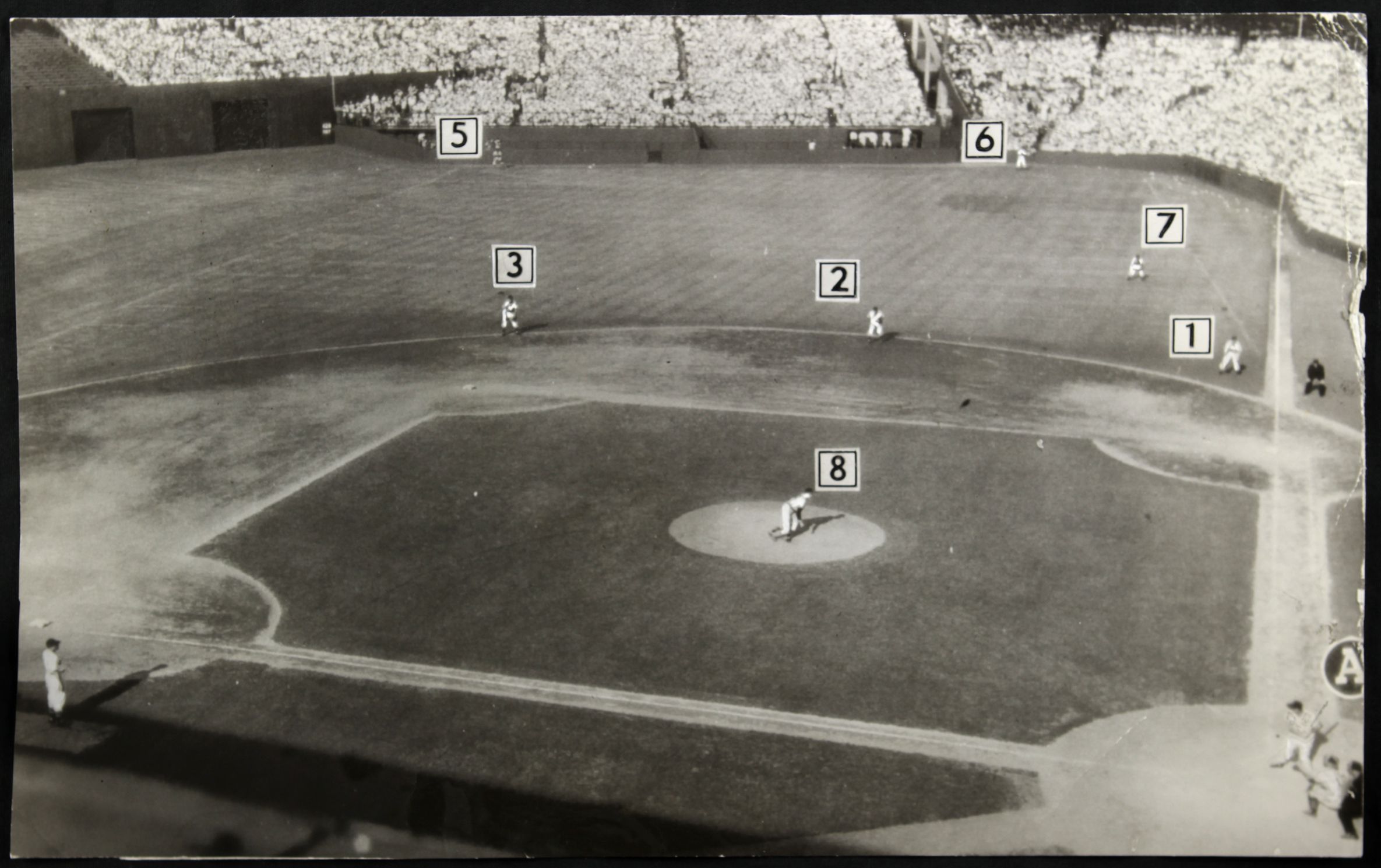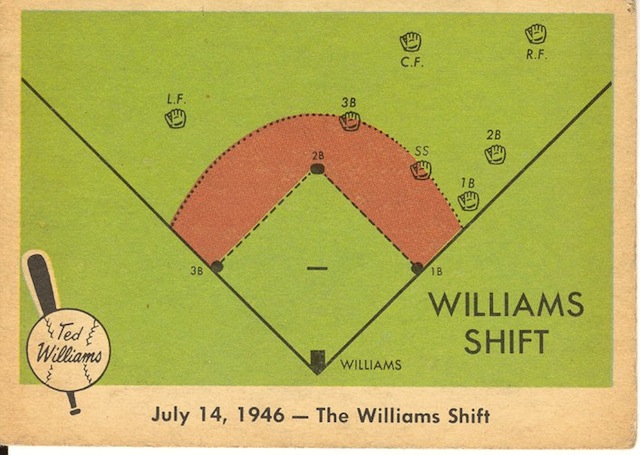Baseball History Comes Alive Now Ranked #2 by Feedspot Among All Internet Baseball History Websites and Blogs!
Guest Submissions from Our Readers Always Welcome!
Vote In Our Weekly Poll Question!
Every week I’m posting a baseball history-related question and will encourage our readers to voice their opinion.
Vote in the poll box to the right. Then feel free to leave your thoughts in the comments section below. We’d love to hear what you have to say!
Here’s a little background info:
Shifts are nothing new. As Jeff Zimmerman noted in the 2014 Hardball Times Annual:
“The shift dates back to at least the 1920s, when opposing managers resorted to the strategy in an attempt to cut down on hits off the bat of Cy Williams. As well, the luminous Babe Ruth faced occasional outfield shifts during his prime seasons. However, it was the “Ted Williams shift” employed by Indians manager/shortstop Lou Boudreau on July 14, 1946 that took things further.”
In the featured photo above, we see a diagram of the “Williams Shift,” as designed by Cleveland manager Lou Boudreau.
In my humble opinion, I do think shifts are hurting the game. My solution: The shortstop and third baseman must be required to stay on the left field side of second base until the ball is hit. Likewise, the second baseman must stay on the right field side of second base until the ball is hit.
Anyway…let’s hear what you have to say!



OK…I just heard from my friend and contributor Bill Gutman. He disagrees with me and asked me to add the following to the debate:
TO BE HONEST, I DON’T THINK SHIFTS ARE HARMFUL. I JUST FEEL THAT THEY’D GO AWAY IF MORE PLAYERS WOULD BUNT OR LEARN TO HIT THE OTHER WAY. IT’S NOT THAT I DON’T LIKE SHIFTS. I DON’T THINK THEY SHOULD BE OUTLAWED. AFTER ALL, FOOTBALL DEFENSES ARE ALLOWED TO ALLIGN THEMSELVES ANY WAY THEY CHOOSE. WHY NOT BASEBALL. BUT IF YOU HAD THE KIND OF HITTERS WE’VE HAD IN THE PAST, THEY WOULD DEFEAT THE SHIFT VERY QUICKLY AND THEY WOULD GO AWAY. OR MOSTLY GO AWAY. SO I DON’T THINK HARMFUL IS THE RIGHT WORD TO USE.
I also wouldn’t say I don’t like shifts. I don’t like the way analytics is beginning to control the game. Shifts are just a strategy that can be beaten. But in today’s home run or strikeout game, it ain’t gonna happen.
I say No.
The shift is not the problem….the problem is the professional hitters’ inability to hit the ball the other way. I play in a vintage league and occasionally, our club obeys the home clubs wish to make all fielders stay within two steps of the bag and have all outfielders play straight up. It realy changes the entire flow of the game. As an amatuer, this is infuriating. I can only imagine how frustrating this would be for players and managers to adjust to. Where does it end? Can infielders not play double play depth or prepare for a bunt? I say make the batter adjust…not the nine guys in the field.
That seems to be the consensus, Richard. The hitters have to adjust. Yet I wonder if the analytics geniuses keep telling them to swing for the fences. I just did a post on Wee Willie Keeler. He would bunt, slap, chop and place the ball. Maybe he was what they call a Punch and Judy hitter, but he was always on base, had great bat control and rarely struck out. They probably wouldn’t want him on the team today. But come on, is it that difficult for a hitter to learn how to go the other way. They’ve done it for a hundred years. Now, all of a sudden, it seems as if they can’t.
When the Red Sox are at bat: yes, I think it’s hurting the game. When they’re in the field, it’s great. First, let’s let the players work it out. See if they don’t start going the other way, dropping a bunt down the third base line.
I’m more concerned about “launch angle” (which, to be fair, could be a reaction the shifting). About four-inning starts and five one-inning relievers. About more strikeouts than basehits last year.
But it’s still a great game. Who was it? Bob Prince? Ernie Harwell? Who used to say “Old Abner’s done it again!”
Poor hitting is hurting today’s game. The inability of batters being able to use the whole field is frustrating to this observer. Once upon a time, if you were a player capable of belting 20 – 25 homers a year, you were a slugger. Today, it seems like all the players are doing it. The over reliance on the homer and lack of fundamental hitting skills (hit and run anybody?) invite the shifts. Don’t outlaw the shifts. Defeat the shifts by becoming more than a one trick pony in the batter’s box.
Totally agree with you Dale. In the early days most players used the whole field. Stan Musial would have laughed at the shift, as would others from his generation. Guys like Pete Rose, Tony Gwynn, Wade Boggs and Rod Carew could beat it without breaking a sweat. Unfortunately — and thanks to analytics — it has become a home run or strikeout game, which is boring to many of us older fans. When there are more strikeouts than hits, something is wrong. But it’s still baseball, our game, and we continue to watch. Maybe the shift will eventually cause the hitters to wake up and we’ll get some of the older game back.
No. What is hurting today’s game is pace of play.
While shifts are part of the over analytic nature of today’s game, it’s not the primary reason. I do believe hitters can modify their swings and ameliorate the shift albeit not entirely.
Between innings take up 36 minutes of a game and closer to 45-50 on a nationally televised game. I still believe that instituting a clock between pitches and keeping the batter in the box would be better.
The clock has worked in the minors .
I think the fuss MLB is making about pace of play is more for the television audience than those in the ballpark. With the high ticket prices, the wide variety of expensive food and all the other distractions, why try to rush fans out of there in, say, two hours and twenty minutes? What few seem to mention is the amount of time it takes to make 10 to 12 pitching changes, which we’re seeing more often now. First a meeting on the mound, then the call to the bullpen followed by a walk or jog to the mound by the reliever. Then another meeting and eight warmup pitches. Put a stopwatch on it and multiply by 12 and see how much time has elapsed without any action. The endless commercials don’t help either. I think it’s the lack of action, i.e. balls in play, that slows the game down for many of us.
Some great comments…Seems like most don’t agree with me that the shifts are hurting the game, but rather that the players should learn how to beat them.
Batters need to adjust. The defense can put fielders wherever they want. As your recent blog subject said, “Hit em where they ain’t!”
On a related note, think of all the specialization that’s happened: DH, closers, openers, starters, 8th inning relievers…
It’s inevitable that beyond the DH in both leagues, someday basetmay get like football, ie the best nine batters will hit and the best nine fielders will field. Why not?
Thanks Rich…that’s an interesting point, never really thought of that, but you might be right.
I would say no and agree with some of the other comments that if hitters went the other way teams would shy away from using the shift but the way the games are played today with lunch angles statistics show more strikeouts and more home runs the hit and run and sacrifice bunt is lost in today’s game especially in The AL I think if teams used the hit and run more often teams would shift less as well
It sure seems like “small ball” is out these days and so are the skills that go with it. This past season I saw the Yankees Greg Bird, a slow runner who was having and awful year, drop two bunts down the third base line and he could have walked to first base. Because of the radical shift on him, no one was near the ball once it got past the pitcher. But I’m sure some analytic guy would say that a power hitter like Bird should never bunt. Just doesn’t make sense to me.
Contrary to the belief that an analyst’s main objective is enhance the purists’ enjoyment of the game, their are other factors at play.
The main goal is to win and sometimes that comes at the expense of the way we remember the game being played in the past. Statistics tell us that players should be more concerned with launch angle so they can hit more home runs. Statistically speaking, this wins more games than a single hit the other way. A home run gives the player more win shares. This earns the player more money. There is no incentive to go back to the pure form of baseball.
So sometimes baseball reacts by changing the rules and parameters in an effort to restore the balance. I don’t think eliminating the shift is the answer. I’m not sure what the answer is but I do know this: It will take more than a lifetime to wait for marginal home run hitters to turn back into slap hitters.
Perhaps a slightly lighter/softer baseball would turn 10% of the home runs back into fly outs. This would have to be tested in a lab and rolled out ever so slightly over time – otherwise the home run happy fans might turn to other means of entertainment. As for us, we’ll always be here. But baseball thrives when it appeals to the masses so we can’t reduce the power game too drastically . . . just ever so slightly until the marginal power hitters find other ways to thrive, win games and make money.